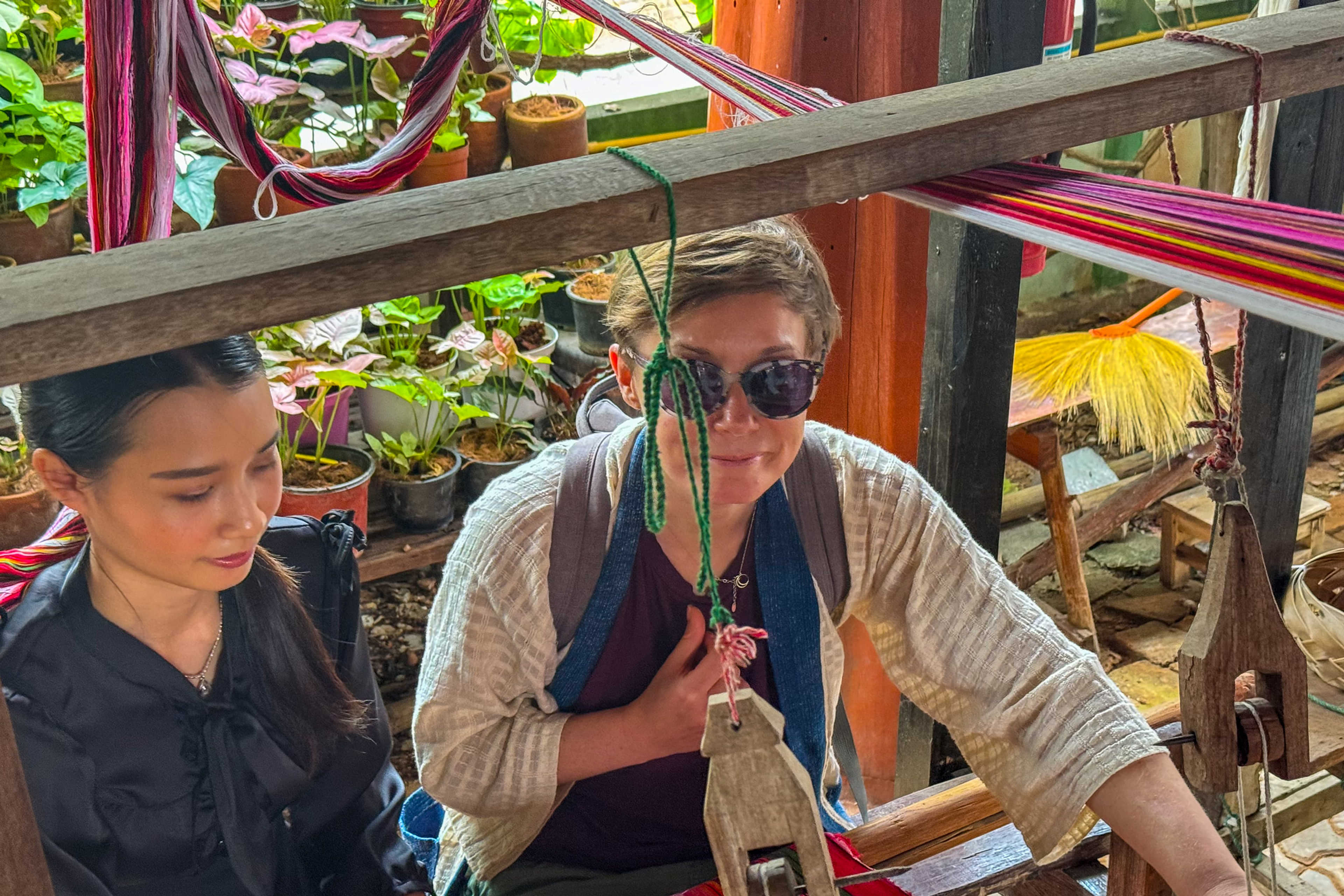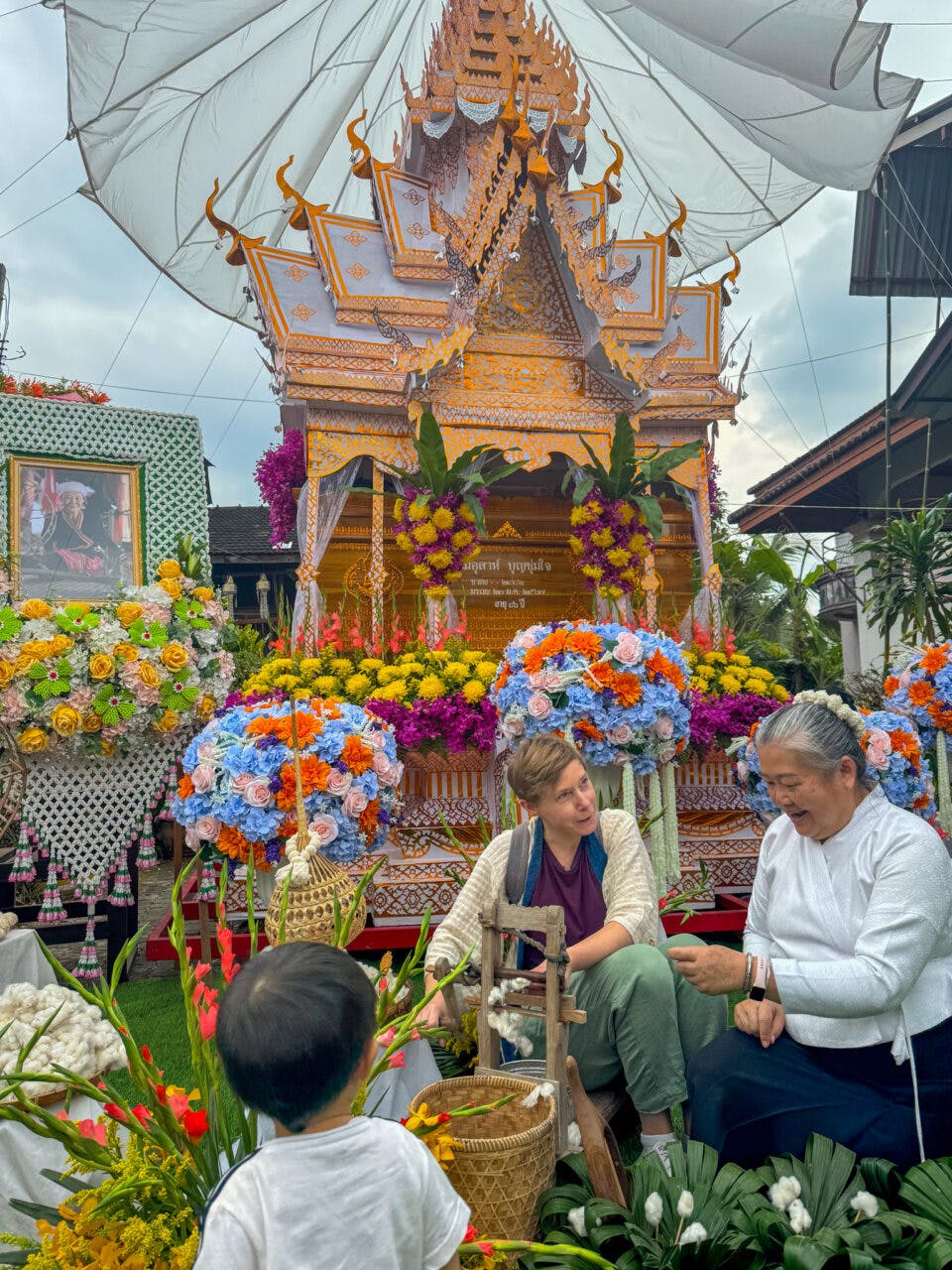
Diary
About death and funerals in Thailand
Destinations
Joanna Horanin
Hi, I'm Joanna, the author of The Blond Travels. In the worlds of Thailand and Portugal, I feel like a fish in water - and it's no coincidence! I've been exploring Thailand for over a decade, and I've settled in Portugal for 6 years now. My mission is to support Dreamers - just like you - in discovering these fascinating countries and helping those in love with them find their own place on Earth, preferably for good! Let's uncover these unique corners of the world together.
The street was full of people dressed in black.
They were coming out of a side street, carrying plastic bags.
We entered the courtyard.
“I think we might be crashing an event of some sort” – said Pyś.
At the Tai Lue’s house in Doi Saket
We were in Doi Saket, near Chiang Mai. We came to the small village to learn more about the Tai Lue mountain minority. We wanted to learn about the customs and their cuisine.
The village had a cultural center for this minority, where they had their sewing room, a kitchen and a guesthouse.
I went inside, I looked around and saw everyone dressed in black.
“It’s a funeral” – whispered Pyś.
A couple of people approached us. We tried to explain what we were looking for and why we had come.
An old woman, who spoke a bit of English, approached us. “What’s your name?” – She asked. “Joanna” – I replied.
She asked us a few more questions, then grabbed a microphone and started singing: “Welcome, Joanna. Welcome.”
In the memory of the deceased
When the song was over, she took us aside, seated us and called a young woman, who explained in English that there was indeed a funeral for this grandmother’s mother (who, by the way, must have been 200 years old).
We were terribly dumbfounded, but apparently not to them, because in a moment someone brought us food, drinks, took us to the sewing room, and showed us how to spin cotton.
Grandma said that her mother was a spinner there, and she would have been very happy to see a foreigner spinning cotton at their place.
In the middle of the yard was a beautifully decorated platform of flowers and cotton balls. On the side stood a tiny wooden yarn, on which each guest could spin the still unspun cotton in memory of the deceased.

Above them all was a closed coffin, standing under a beautifully carved canopy.
The grandmother asked me to sit by the wooden yarn and showed me how to wind the cotton through a special press to get rid of the seed that was inside. While I was doing the tasks, she and the other elderly women who came to us were singing a Thai song.
“My mother would be happy if she knew that a foreigner was spinning at her funeral,” – Grandma said again to me.
Thais’ approach to death
Isn’t that wonderful, Dreamer? To memorialize a deceased person in this way? To make available to guests what the deceased was famous for? To celebrate a life well lived? To rejoice that the person lived and was part of our lives?
In Buddhism, death is an integral part of life, something that must happen and comes inexorably.
A good death in Thai culture is one where one dies with a clear mind, without regret. This in turn leads to a better life, perhaps being born as someone better, richer, happier, or to enlightenment and Nirvana itself. Therefore, in the religion here, one is urged to live a peaceful, dignified life, to behave in a good way and be helpful to others.
So if someone was generally a good person during his or her lifetime, was respected in society and lived a long life, it is believed that this person will have a good second life or achieve enlightenment. This is also why at many funerals not much sadness is shown, although such sadness is of course felt.
Thai funerals – What do they look like in practice?
Depending on where you are, a Thai funeral may look slightly different. For example, in the case of Tai Lue, one commemorates the deceased by spinning a piece of cotton. It is also a well-known practice to put the deceased or deceased’s favorite things in the coffin.
Funerals in Thailand take a long time and can take months if the deceased was highly placed in the hierarchy of the society. In the case of King Rama IX, for example, his cremation did not take place until 100 days after the body was placed in the coffin.
The first thing that is done after death is to wash the corpse. The body is put on display in the house, and guests can come up and pour water from small vessels onto the hands of the deceased. Then, the body is put out for another 3, 5 or 7 days so that family, friends and neighbors can come for prayers. As I mentioned, this time can be extended, depending on the status.
At the very end comes the cremation, which takes place in a crematorium next to the temple. Often a large structure, a sort of pyre, is set up behind the temple and the body is burned there.
Thai people at the funerals
Thais dress in black for a funeral, but I have also seen people dressed in white. I’m not sure about that, but it seems to me that the family of the deceased determines how one must dress. Colors in Thailand are important and symbolic, so it is worth paying attention to this if you are going to a funeral in Thailand.
Visitors gather at the deceased person’s home. Music may then be played, someone may sing, women then sit together and prepare decorations for the cremation.
In some cases, small fireworks are also shot, the same ones you’ll see and hear at Chinese New Year.
Do people cry and get sad? Crying can occur, so can sadness. it is a normal human reaction to such an event. If the person was old, sick and died with a clear conscience, the sadness will certainly be not so clear. In such cases, religion tells us to rejoice. Mourning the loss of young people is certainly more palpable.
Thai funerals are certainly quite different from those in the West in general. However, one must always be mindful to behave respectfully and attentively, and not treat a funeral in Thailand like a circus and another photo opportunity.
Before we left, we were still taken to a room with spinning machines and shown how colorful traditional costumes are made. We actually didn’t feel comfortable. We didn’t know if it was appropriate to stay. So we took the food we were given to take away and went on our way. We will return soon to get to know the Tai Luea tribe better.